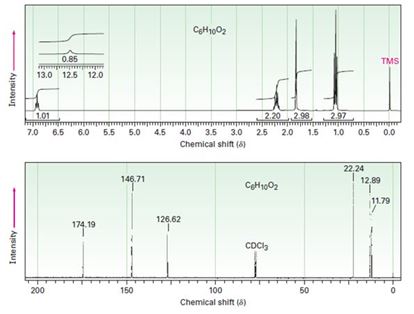
Bundle: Organic Chemistry, 9th, Loose-Leaf + OWLv2, 4 terms (24 months) Printed Access Card
9th Edition
ISBN: 9781305701021
Author: John E. McMurry
Publisher: Cengage Learning
expand_more
expand_more
format_list_bulleted
Concept explainers
Textbook Question
Chapter 20.SE, Problem 68AP
The 1H and 13C NMR spectra below belong to a compound with formula C6H10O2. Propose a structure for this compound.

Expert Solution & Answer
Trending nowThis is a popular solution!

Students have asked these similar questions
Please correct answer and don't used hand raiting
Please correct answer and don't used hand raiting
Please correct answer and don't used hand raiting
Chapter 20 Solutions
Bundle: Organic Chemistry, 9th, Loose-Leaf + OWLv2, 4 terms (24 months) Printed Access Card
Ch. 20.1 - Give IUPAC names for the following compounds:Ch. 20.1 - Draw structures corresponding to the following...Ch. 20.2 - Prob. 3PCh. 20.2 - The Ka for dichloroacetic acid is 3.32 Ă— 10-2....Ch. 20.3 - Calculate the percentages of dissociated and...Ch. 20.4 - Which would you expect to be a stronger acid, the...Ch. 20.4 - Dicarboxylic acids have two dissociation...Ch. 20.4 - The pKa of p-cyclopropylbenzoic acid is 4.45. Is...Ch. 20.4 - Prob. 9PCh. 20.5 - Prob. 10P
Ch. 20.6 - Prob. 11PCh. 20.6 - How might you carry out the following...Ch. 20.7 - Prob. 13PCh. 20.7 - Prob. 14PCh. 20.8 - Cyclopentanecarboxylic acid and...Ch. 20.8 - Prob. 16PCh. 20.SE - Prob. 17VCCh. 20.SE - Prob. 18VCCh. 20.SE - The following carboxylic acid can’t be prepared...Ch. 20.SE - Electrostatic potential maps of anisole and...Ch. 20.SE - Predict the product(s) and provide the mechanism...Ch. 20.SE - Predict the product(s) and provide the mechanism...Ch. 20.SE - Prob. 23MPCh. 20.SE - Predict the product(s) and provide the complete...Ch. 20.SE - Acid-catalyzed hydrolysis of a nitrile to give a...Ch. 20.SE - Prob. 26MPCh. 20.SE - Naturally occurring compounds called cyanogenic...Ch. 20.SE - 2-Bromo-6, 6-dimethylcyclohexanone gives 2,...Ch. 20.SE - Naturally occurring compounds called terpenoids,...Ch. 20.SE - In the Ritter reaction, an alkene reacts with a...Ch. 20.SE - Give IUPAC names for the following compounds:Ch. 20.SE - Prob. 32APCh. 20.SE - Prob. 33APCh. 20.SE - Prob. 34APCh. 20.SE - Prob. 35APCh. 20.SE - Prob. 36APCh. 20.SE - Prob. 37APCh. 20.SE - Prob. 38APCh. 20.SE - Calculate the Ka's for the following acids: (a)...Ch. 20.SE - Thioglycolic acid, HSCH2CO2H, a substance used in...Ch. 20.SE - Prob. 41APCh. 20.SE - Prob. 42APCh. 20.SE - How could you convert butanoic acid into the...Ch. 20.SE - How could you convert each of the following...Ch. 20.SE - How could you convert butanenitrile into the...Ch. 20.SE - How would you prepare the following compounds from...Ch. 20.SE - Prob. 47APCh. 20.SE - Using 13CO2 as your only source of labeled carbon,...Ch. 20.SE - Prob. 49APCh. 20.SE - Which method-Grignard carboxylation or nitrile...Ch. 20.SE - Prob. 51APCh. 20.SE - Prob. 52APCh. 20.SE - Propose a structure for a compound C6H12O2 that...Ch. 20.SE - Prob. 54APCh. 20.SE - How would you use NMR (either 13C or 1H) to...Ch. 20.SE - Prob. 56APCh. 20.SE - A chemist in need of 2,2-dimethylpentanoic acid...Ch. 20.SE - Prob. 58APCh. 20.SE - Prob. 59APCh. 20.SE - Prob. 60APCh. 20.SE - Prob. 61APCh. 20.SE - Prob. 62APCh. 20.SE - Prob. 63APCh. 20.SE - The following pKa values have been measured....Ch. 20.SE - Identify the missing reagents a-f in the following...Ch. 20.SE - Propose a structure for a compound, C4H7N, that...Ch. 20.SE - Prob. 67APCh. 20.SE - The 1H and 13C NMR spectra below belong to a...Ch. 20.SE - Propose structures for carboxylic acids that show...Ch. 20.SE - Carboxylic acids having a second carbonyl group...
Knowledge Booster
Learn more about
Need a deep-dive on the concept behind this application? Look no further. Learn more about this topic, chemistry and related others by exploring similar questions and additional content below.Similar questions
- Saved v Question: I've done both of the graphs and generated an equation from excel, I just need help explaining A-B. Below is just the information I used to get the graphs obtain the graph please help. Prepare two graphs, the first with the percent transmission on the vertical axis and concentration on the horizontal axis and the second with absorption on the vertical axis and concentration on the horizontal axis. Solution # Unknown Concentration (mol/L) Transmittance Absorption 9.88x101 635 0.17 1.98x101 47% 0.33 2.95x101 31% 0.51 3.95x10 21% 0.68 4.94x10 14% 24% 0.85 0.62 A.) Give an equation that relates either the % transmission or the absorption to the concentration. Explain how you arrived at your equation. B.) What is the relationship between the percent transmission and the absorption? C.) Determine the concentration of the ironlll) salicylate in the unknown directly from the graph and from the best fit trend-line (least squares analysis) of the graph that yielded a straight…arrow_forwardDon't used Ai solutionarrow_forwardCalculate the differences between energy levels in J, Einstein's coefficients of estimated absorption and spontaneous emission and life time media for typical electronic transmissions (vnm = 1015 s-1) and vibrations (vnm = 1013 s-1) . Assume that the dipolar transition moments for these transactions are in the order of 1 D.Data: 1D = 3.33564x10-30 C m; epsilon0 = 8.85419x10-12 C2m-1J-1arrow_forward
- Don't used Ai solutionarrow_forwardPlease correct answer and don't used hand raitingarrow_forwardIn an induced absorption process:a) the population of the fundamental state is diminishingb) the population of the excited state decreasesc) the non-radiating component is the predominant oned) the emission radiation is consistentarrow_forward
arrow_back_ios
SEE MORE QUESTIONS
arrow_forward_ios
Recommended textbooks for you

 Organic ChemistryChemistryISBN:9781305580350Author:William H. Brown, Brent L. Iverson, Eric Anslyn, Christopher S. FootePublisher:Cengage Learning
Organic ChemistryChemistryISBN:9781305580350Author:William H. Brown, Brent L. Iverson, Eric Anslyn, Christopher S. FootePublisher:Cengage Learning


Organic Chemistry
Chemistry
ISBN:9781305580350
Author:William H. Brown, Brent L. Iverson, Eric Anslyn, Christopher S. Foote
Publisher:Cengage Learning
Coenzymes and cofactors; Author: CH15 SWAYAM Prabha IIT Madras;https://www.youtube.com/watch?v=bubY2Nm7hVM;License: Standard YouTube License, CC-BY
Aromaticity and Huckel's Rule; Author: Professor Dave Explains;https://www.youtube.com/watch?v=7-BguH4_WBQ;License: Standard Youtube License